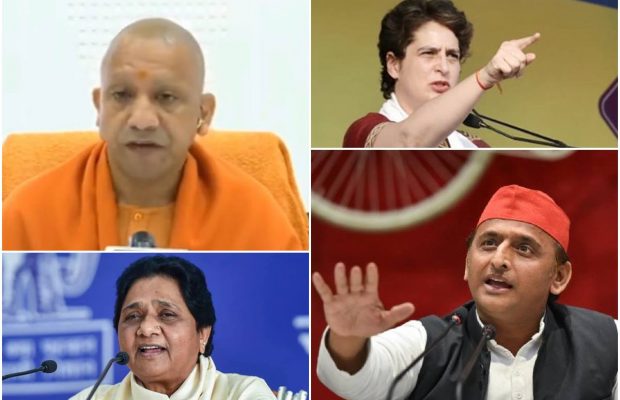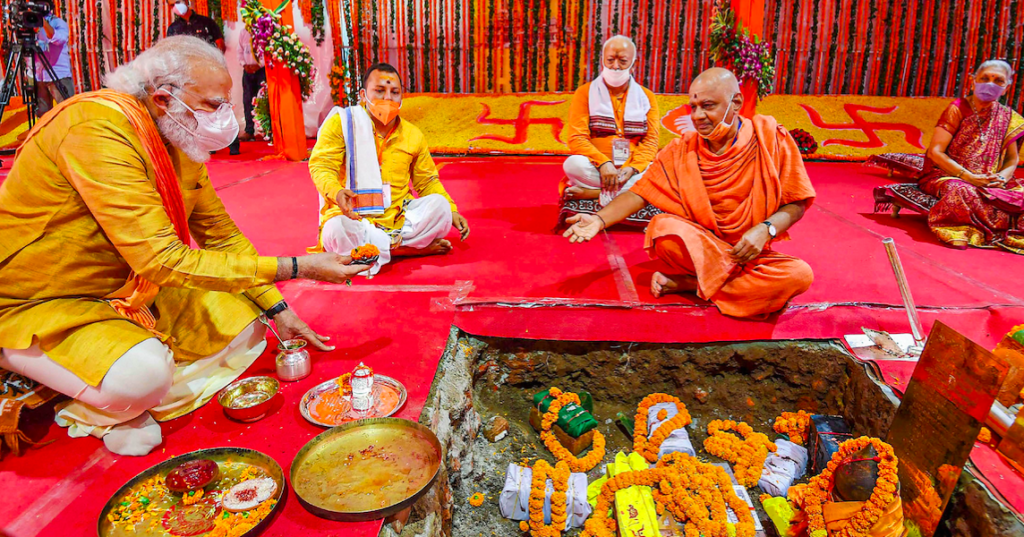
Communalisation of votes is not an unfamiliar practice for Indian political parties. The swaying of votes by radical speeches has been a common practice for years. In the last few decades, Uttar Pradesh (U.P) has been a complex political battleground with the highly wrangled issue of ‘Babri Masjid/Ram Janambhoomi’ taking center-stage for the most part.
The electoral history of the country and consequently of the states witnessed an uncertain era of Emergency between 1975-77. In the context of Uttar Pradesh, the quandary began much before that period. Soon after the assembly election of 1967 – along with the appointment of the first non-Congress Chief Minister – a series of President’s rule began that lasted for a few years and included the Emergency of 1975-77. This duration witnessed six Chief Ministers being in power at irregular intervals. The Assembly elections of 1977, held in the wake of the Emergency being lifted, saw a monumental victory for the Janata Party which garnered 47.8% votes from the people of UP as well.
The changing national and regional trends influenced the politics of the state with issues of Mandal and Ayodhya taking centre stage in Uttar Pradesh’s politics in general and elections in particular. Caste lines became sharper with the anti-Mandal agitations gaining momentum . OBCs, Dalits and Muslims were identified as en bloc voting communities. Political alliance of being formed by Bahujan Samaj Party’s Mayawati and Samajwadi Party’s Mulayam Singh Yadav against the upper caste dominance in Uttar Pradesh, however, did not last long and led to Mayawati being the first female low-caste Chief Minister of Uttar Pradesh with support from BJP. Yet the instability of the government was prevalent through witnessing ten Chief Ministers and three President’s Rule in the next thirteen years.It was only in 2012 that Mayawati became the first Chief Minister to go to the polls after completing her full term. The assembly election of 2017 marked the rise of the Bharatiya Janata Party in the state and the consequent emergence of ‘Hindutva’ politics that afflicted both Uttar Pradesh and the country at large, especially in the last few years. The final verdict of the Supreme Court on the Ayodhya land dispute was given in 2019 in favor of the Hindu community. Subsequently, a ‘Bhoomi pujan’, that is, the religious start to the construction of the Ram Mandir, was held at the site. Prime Minister Narendra Modi of BJP, partook in the as a central figure, thereby sending a strong communal message to the national public.

The construction of a ‘temple’ is becoming the foremost agenda for the party in the public eye, especially in the upcoming assembly election of 2022. There are two key issues of Uttar Pradesh politics at play for the upcoming assembly election. First is the resurfacing of the Mandal issue amongst the BJP leaders. An interesting element at work has been the mainstream caste-centric political parties aligning their forces with numerous smaller caste-specific parties. Pre-poll tie-ups are not a unique phenomenon and while the Samajwadi Party has kept its doors open for smaller parties, the BJP is also trying to keep its alliance intact with them. From a time when smaller parties used to flock to bigger parties, the situation has turned on its head in Uttar Pradesh. Such a narrative is a direct response to the twin issues of Mandal and Mandir of the 1990s. Recently, Yogi Adityanath’s party has been on the receiving end of the caste-based deflections of its members. A number of Dalit and Other Backward Classes political leaders have already resigned and many more are planning to abdicate to the Samajwadi Party. A critical intersection of the two key issues of UP politics will be at play this election. Moreover, if voted to power, Akhilesh Yadav, Samajwadi Party chief, promises to conduct a caste census, to give people their rights in accordance to their share in the population, in UP within three months
Secondly, the Congress has brought another element to life through the slogan “ladki hoon, ladh sakti hoon”. The first candidate list of the party includes 40% youth leaders and 50 out of 125 women leaders for the polls. The party has committed to providing 40% of the seats in this year’s Uttar Pradesh election to female candidates, which is reflected even in its third list.
An opinion poll was conducted by Times Now ahead of elections. The opinion poll projected Yogi Adityanath-led BJP to return to power in the Uttar Pradesh elections in 2022. While Samajwadi Party is expected to improve its performance as compared to the 2017 polls, the Bahujan Samaj Party (BSP) and Congress are expected to perform very badly. However, the ultimate verdict lies in the hands of the people of the state. The elections are scheduled to be held from 10 February to 7 March 2022 in seven phases to elect all 403 members of the Uttar Pradesh Legislative Assembly. The votes are to be counted and the results will be declared on 10 March 2022.
Khyati is a third year History student at Lady Shri Ram College for women. She believes that words have the power to change the society, and tends to use these. Interested in research, she's expecting to pursue the same in furure.



With all the doggone snow we have gotten as of late I am stuck inside , fortunately there is the internet, thanks for giving me something to do.
So you are a man or woman?
Where there is a will, there is a way.
Nice post. I learn something more challenging on different blogs everyday. It will always be stimulating to read content from other writers and practice a little something from their store. I’d prefer to use some with the content on my blog whether you don’t mind. Natually I’ll give you a link on your web blog. Thanks for sharing.
I do agree with all the ideas you have presented in your post. They’re really convincing and will certainly work. Still, the posts are very short for newbies. Could you please extend them a little from next time? Thanks for the post.
Excellent read, I just passed this onto a friend who was doing some research on that. And he actually bought me lunch because I found it for him smile Thus let me rephrase that: Thanks for lunch!
Excellent web site. Lots of helpful information here. I’m sending it to some buddies ans additionally sharing in delicious. And obviously, thanks on your effort!
There is noticeably a bundle to know about this. I assume you made certain nice points in features also.